Unit 1 Sustainable Infrastructure
This chapter introduces the need for infrastructure, the problem of sustainability, and the concept of sustainable infrastructure.
1.1 Infrastructure
Let’s consider the leading causes of death in the United States in 1900 and 2010 shown in Figure 1.1. First, note that the life expectancy is longer, meaning that fewer people per capita die each year of any cause. Consider ailments like diphtheria, gastro-intestinal infections (like cholera), and pneumonia. These diseases which were formerly leading causes of death have almost disappeared as threats in modern life. Medical science has played a major role, especially through antibiotics and vaccines. But think of all of the engineering improvements that have played a major role in this lifesaving trend:
- Water systems bring clean water into homes, and remove dirty water through sewage and treatment systems. Cholera and diphtheria outbreaks are virtually impossible in modern cities.
- Electricity networks power domestic refrigeration units, keeping food at safe temperatures.
- Transportation systems bring fresh produce to supermarkets in any climate during all seasons, promoting nutrition and economic growth.
- Structures are considerably less vulnerable to fires, earthquakes, and any other number of catastrophes, reducing loss of life in accidents.
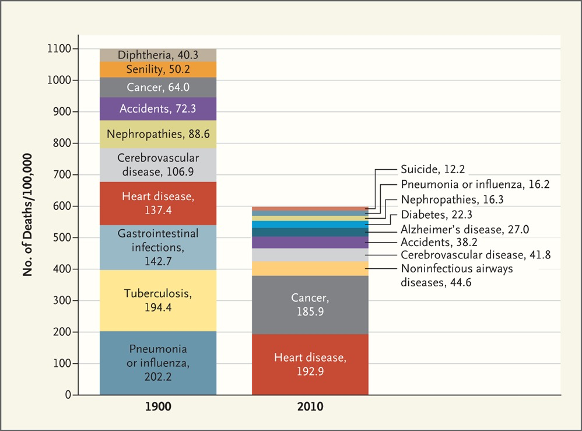
Figure 1.1: Leading causes of death in the United States in 1900 and 2010. Data from the Centers for Disease Control and Prevention via Jones, Podolsky, and Greene (2012)
These facilities designed by engineers for civil society — roads, buildings, dams, sewers, aqueducts, tunnels, ports, power plants, bridges, etc. — are collectively referred to as infrastructure. Without adequate infrastructure, a prosperous and healthy society is unlikely. Infrastructure enables people to work, travel, and live in today’s world.
One of the central struggles with infrastructure in society is that it costs money to build it, and once something is built it costs money and effort to maintain. The American Society of Civil Engineers (ASCE) publishes an an Infrastructure Report Card every four years. The most recent report card is shown in Figure 1.2, and you can see that on these metrics, the United States could be doing better. Now, it’s important to point out that the purpose of this report card is to lobby government to spend money on infrastructure projects, thereby benefiting civil engineers. But the fact remains that many of the facilities collectively comprising America’s infrastructure are not getting any younger, and will need repair or replacement in the near term.
For an international and non-lobbyist perspective, the 2019 World Economic Forum Global Competitiveness Index tries to measure and compare countries by how well-equipped they are to foster economic development. This includes political structures, legal systems, and — unsurprisingly — infrastructure. Figure 1.3 shows how the United States scores on these metrics, as well as identifying the countries that are ranked first in each metric. Overall, the U.S. comes in second behind Singapore. The U.S. scores highly in the openness of its markets, the consistency of its legal system, and its ability to innovate. In the infrastructure category, however, the U.S. is only 13th of the 141 countries included (Singapore leads in this category as well).
](images/infrastructure.png)
Figure 1.3: US 2019 Global Competitiveness Summary (weforum.org)
One disadvantage the United States faces relative to other countries is that it made a series of massive infrastructure investments in the middle of the 20th Century, from the New Deal-era hydroelectric projects along the Tennessee and Colorado Rivers to the Interstate Highway System. During the same time period, the infrastructure of other developed nations in Europe and Asia was effectively destroyed in World War II, and their economies were crippled as a result. But in the intervening decades, these other countries have improved their infrastructure with more modern techniques and practices, setting the United States comparatively behind some of its peers.
But why is this this the case? Why can’t a nation simply build great infrastructure and then continue maintaining and expanding that infrastructure so that it remains performant, relevant, and in good repair? Why didn’t we as a nation sustain this advantage? It’s a good question without a simple answer.
1.2 Sustainability
When was the last time you spun a top? For how long did it spin? Eventually, even the most well-calibrated tops spinning on the smoothest possible surfaces will topple as the combined forces of gravity, air resistance, and friction overwhelm the angular momentum of the top. Because the top cannot spin forever, this system is unsustainable.1

Figure 1.4: Spinning top. Image copyright Warner Brothers / Legendary Pictures.
A top is not a very consequential system. But other systems, including the economy and the various systems that compose public infrastructure, have a lot riding on them. It is not hyperbole to say that when these systems fall apart, large numbers of people suffer poverty and death. Keeping these systems going indefinitely needs to be the goal. The science of designing human and physical systems so that they will operate indefinitely is called sustainability. Sustainability is a technical problem rooted in an ethical question: how can we use the earth’s resources in such a way that they are available to future generations?
1.2.1 Triple Bottom Line
There are three main dimensions of sustainability, sometimes called the triple bottom line. These dimensions are:
- Economic Does the system cost more to operate than its operation justifies?
- Environmental Does the system extract resources from the environment more quickly than they can be replenished?
- Social: Does the system balance costs and benefits equitably among different groups?
All three dimensions of sustainability must be handled, or the system will eventually collapse: If a system is economically sustainable but exerts an unacceptable social or environmental toll, then the system is unsustainable. Because of this, the ordering of the three dimensions is immaterial.
1.2.1.1 Economic
Many of us have looked at an old car in need of repairs, and tried to determine if we would spend more money making the car work again than we would obtaining and maintaining a newer, or different car. Or even if we would spend more money keeping the old car on the road than we could earn by driving it to a job. If the cost of keeping a system running exceeds the benefit derived from that system, it is unsustainable.
In terms of infrastructure, this question can come in many different ways. It is cheaper to repair a pavement than replace it. But a pavement repair needs to occur regularly, or the pavement will deteriorate to the point that it must be replaced. But many cities do not have sufficient funds to repair the pavement frequently, meaning that they prioritize the roads in the worst condition for more expensive replacement. This is unsustainable: eventually more roads will need to be replaced than the city can budget for, and the quality of the entire road system begins to degrade.
What would need to change to make this pavement maintenance system economically sustainable?
1.2.1.2 Environmental
Environmentalism and conservation are some of the words many people associate with sustainability. These are important concepts, but sustainability means something different. Environmentalism and conservation concern protecting natural habitats from degradation or destruction. Environmental sustainability is more concerned with the manner of resource use and extraction, and whether the environment can perpetually bear the cost of human activity.
To see the difference, consider a timber forest. A conservation approach might try to prohibit logging in that forest in an effort to preserve habitat for wildlife or for other reasons. A sustainability approach would instead identify ways to extract timber from the forest that can be sustained indefinitely. This might include limits on how much timber can be extracted so that the forest can regenerate itself, seasons when logging is permissible, and techniques for harvesting and transporting timber that minimize impact on the forest environment. There may be cases where a sustainable logging practice cannot be developed; in this case, sustainability and conservation reach the same conclusion.
Given the distinction between environmental sustainability and environmental conservation, could an economy based on fossil fuel extraction and consumption ever be considered sustainable?
1.2.2 Sustainable Development
Sustainability is a fundamentally global issue. Earth’s resources are distributed inequitably across its surface. This causes problems for resource-poor nations who might struggle to provide opportunities for their citizens, but also for resource-rich nations that might be exploited by more powerful nations. The consequences of sustainability issues are also unequally distributed: sea level rise caused by climate change is a more serious threat to the Maldives and the Netherlands than to Switzerland or Nepal, regardless of the role those nations might play in causing climate change. Strategies to mitigate climate change require international cooperation, because one or two large economy holdouts can negate the sustainability progress made by others.
Reflecting the global challenge of sustainability, the United Nations adopted 17 Sustainable Development Goals in 2015. These goals cover all elements of the triple bottom line in multiple dimensions, and serve to draw attention to the biggest challenges that our planet faces.
](images/sustainable_development.png)
Figure 1.5: United Nations Sustainable Development Goals. Website
1.3 Urbanization and Sprawl
Fully agrarian societies are highly sustainable. Pre-industrial agriculture has low environmental impact, a modest return on investment (in typical years), and and generates relatively little variation between rich and poor. But there is low variation because almost everyone is poor, and living standards in such societies are low: life expectancy is short, infant mortality is high, and there are relatively few opportunities for cultural expression and thought.
We will discuss more about comparative advantage later, but for now we can simply assert that by living close to other people, it is possible for individuals to specialize. When everyone is a farmer, everyone has to make their own tools and those tools might not be well made. But if one person is a blacksmith and sells better tools to lots of farmers, everyone is better off. But that blacksmith needs to invest time and money in a forge and tools and training that will leave little extra time for successful farming, so the blacksmith will need to locate in a place where he or she can access many other farmers. When you repeat this for blacksmiths, bankers, coopers, doctors, merchants, and many other professions that require training or special equipment, you begin to have a town, and then a city. This process of people moving from an agrarian society to a community — and usually learning a trade instead of practicing subsistence agriculture — is called urbanization.
Urbanization has happened throughout human history2, but it has accelerated since the industrial revolution in the 19th century. Figure 1.6 shows the growth of urban populations over the last sixty years in a selection of countries. Western developed nations tend to have urbanization rates over 80%, while the world average passed 50% for the first time in 2010. This average is still rising, driven largely by rapidly increasing urbanization in India, China, and sub-Sarahan Africa.
.](Sustainable_Infrastructure_files/figure-html/urbanization-1.png)
Figure 1.6: Urbanized population for selected countries and world population-weighted average. Data from the World Bank / United Nations.
There is obviously an upper limit of 100% urbanization that has has already been reached in places like Singapore and Hong Kong, but even these areas experience immigration and native population growth. Is perpetually increasing urban population growth sustainable? This is an important question, but for the most part we (civil engineers, city planners, etc.) need to take perpetual urban growth as a fact, and build infrastructure that makes this growth sustainable in each dimension of the triple-bottom line. This is not easy, as the following examples will illustrate.
1.3.1 Suburban Sprawl
Many regions — especially in the United States — have experienced a form of quasi-urbanization — literally, sub-urban — where urban population growth agglomerates on the edges of metropolitan areas where land is cheap. Households build large homes on larger tracts of land, aided by tax and zoning policies that incentivize or even require this kind of development, and supported by high private vehicle ownership rates. This leads to all kinds of unsustainable situations:
- Social:
- Automobiles are the only viable form of transport, excluding the poor and some with disabilities from participating productively in society.
- Automobiles are a major contributor to air pollution, exacerbating respiratory illness.
- Environmental:
- Large amounts of land are consumed, destroying wildlife habitat or agricultural land in an unsustainable way.
- Water consumption — often for lawns — increases faster than it can be seasonably replenished, leading to aquifer drawdown and reservoir depletion.
- Water runoff patterns are changed by urban development (see Figure 1.7).
- High energy use from air conditioning and transportation is a major factor in climate change.
- Economic:
- Demand for road infrastructure increases faster than tax revenues, leading to underfunded maintenance needs and traffic congestion.
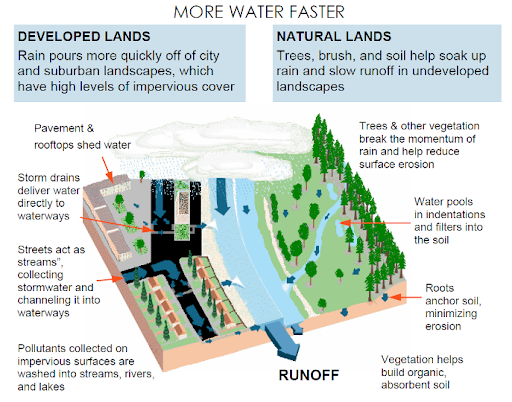
Figure 1.7: Water runoff in urban versus natural land use.
1.4 Climate Change
We questioned earlier whether an economy built on fossil fuels could be sustainable. There are reasonable uncertainties regarding how long the current system could be sustained in terms of unknown and unexplored reserves. What is considerably more certain however, is that were we to consume a large portion of those fuel resources, the earth’s climate could be dramatically altered.
Climate change describes the long-term fluctuations in temperature, precipitation, wind, and all other aspects of Earth’s climate. Kibert (2016) suggests
The main cause of climate change is the dramatically increasing emissions of carbon gasses, mainly carbon dioxide (CO2), into the atmosphere from fossil fuel combustion by power plants, transportation, building energy systems, cement production, and agriculture. At the same time, Earth is losing its ability to stabilize CO2 concentrations because biomass, such as forests, which absorb CO2 are being lost to land development, deforestation, and mining. The combination of rapidly increasing emissions and decreasing absorption capacity is accelerating the atmospheric concentrations of CO2. Climate change gasses like CO2 trap solar energy, and as their atmospheric concentrations rise, average global atmospheric temperatures also increase. The likely results will be rapidly rising sea levels, substantially reduced crop yields, drought, and more energetic hurricanes and cyclones.
Figure 1.8 shows the correlation between atmospheric carbon dioxide and global mean surface temperatures for the last 120 years. Correlation is not causation of course, but in this case there is a great deal of causal evidence that atmospheric carbon dioxide:
- is highly predictive of global mean temperatures, based on evidence from ice core samples dating tens of thousands of years in the past.
- has a physically verifiable mechanism by which it admits and traps solar energy.
- has an observable drastic increase in the last two hundred years almost entirely attributable to human activity, in the form of fossil fuel consumption and deforestation.
On top of atmospheric carbon dioxide, there are feedback cycles that are expected to accelerate climate change. As the arctic ice cap melts, the exposed ocean water absorbs more solar heat than the ice previously reflected, accelerating warming. There are also frozen bogs and swamps in Canada and Siberia that begin emitting carbon dioxide and other greenhouse gasses as they thaw.
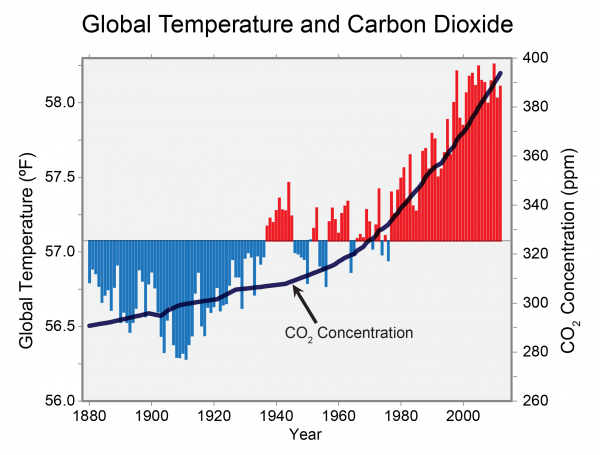
Figure 1.8: Global mean temperature and atmospheric carbon dioxide. From Melillo et al. (2014).
Climate change is interrelated with the sustainability of infrastructure systems in two distinct ways: mitigation and adaptation.
1.4.1 Mitigation
The goal of climate change mitigation is to change human behaviors and systems so that the climate will change less than currently forecast. There are a few basic strategies to do this:
- Reduce the amount of carbon dioxide and other greenhouse gases emitted by human activities.
- Increase the earth’s capacity to absorb carbon dioxide, such as increasing the total volume of vegetation.
- Reduce the amount of solar energy absorbed by earth’s surface to offset the greenhouse effect.
Figure 1.9 shows greenhouse gas emissions by sector over the last thirty years. The three largest sectors are transportation, electricity generation, and industry. But it is worth digging more into what some of these sources are. Fossil fuels are a large and obvious culprit. Less obvious, however is concrete; refining portland cement emits large amounts of carbon dioxide through running the refinery ovens, and the actual chemical process of creating the cement.
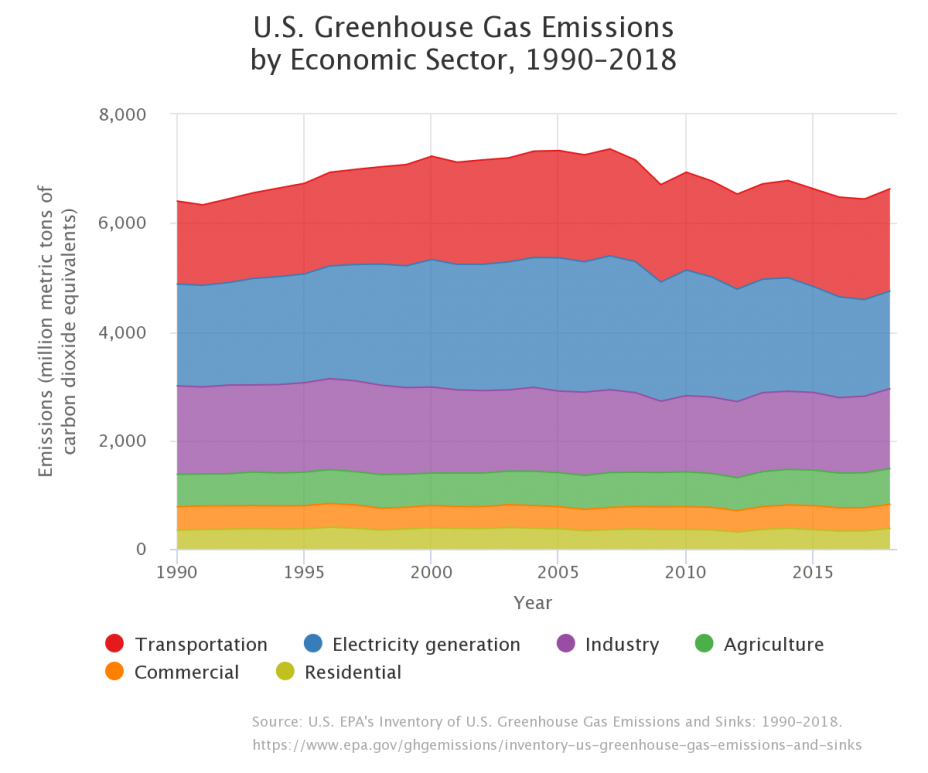
Figure 1.9: U.S. greenhouse gas emisisons by source.
One of the most important techniques is to conduct a life cycle cost (LCC) analysis of a project, in terms of both money and energy. This must consider not just the cost and energy of constructing a project, but also the the energy cost of the materials used, as well as the cost of repurposing, rebuilding, or demolishing and recycling a project (See Figure 1.10. This will ensure that the project remains useful even if its intended purpose fades away. A LCC analysis might also discover that construction materials that are renewable or energy-saving could deliver long-term economic savings
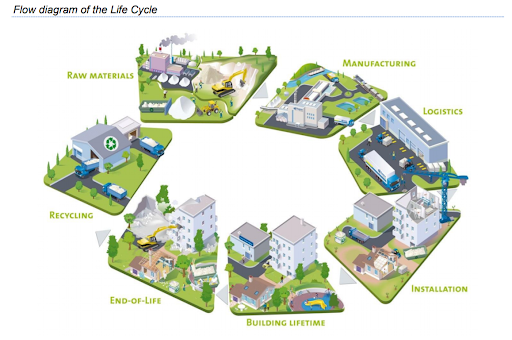
Figure 1.10: Life cycle for buildings.
When choosing building materials, it is important to consider the embodied energy of products and materials. This holistic evaluation of embodied energy is a key factor used to assess the sustainability of a construction material or product. Sustainable materials and products have low levels of embodied energy. A material that is locally sourced and is relatively un-processed will have a low level of embodied energy. Materials that have high levels of embodied energy are generally not sustainable and should be avoided where possible. However, it is often the case that embodied energy of a material may be insignificant in comparison to its potential to save energy over the operational lifetime of the building. Raw and engineered timber that has been sustainably harvested and processed actually removes carbon from the atmosphere and stores it until and unless the timber is incinerated. Some concrete also can absorb carbon from the atmosphere. Also, materials like aluminum have very high embodied energy if refined from bauxite, but are easily recycled. For these reasons material selection for a building is complex and requires careful consideration to find and use materials which deliver on all aspects of sustainability.
Other ideas abound. Buildings can be designed in ways that limit heat absorption in the summer and maximize it in the winters, lowering energy expenditures. Neighborhoods and cities can be laid out in ways that maximize the usefulness of walking and public transit, or that minimize water consumption while remaining pleasant and green.
1.4.2 Adaptation
The goal of climate change adaptation is to engineer systems so that human activity can continue in an altered global climate. The consequences of climate change are both dire and highly unpredictable. Warmer oceans will generate more frequent and energy-intensive hurricanes. Melting antarctic and Greenlandic ice sheets will raise sea levels, inundating some coastal regions. Some areas will experience desiccation and drought, while others will see more frequent deluges. Glaciers and snowpack might be reduced or eliminated, threatening municipal water supplies.
At this point it is unlikely that all deleterious effects of climate change can be avoided. Engineers need to understand how climate change might affect their current practices, and how these practices might need to adapt. For example, a coastal structure might need to withstand elevated or more powerful tides resulting from rising sea levels. What used to be a 100-year storm could become 50- or 20-year storm, meaning that culverts and drainage systems need to be engineered for a considerably larger storm surge. Existing culverts and drainage systems might need to be prioritized for replacement.
1.4.3 Unintended Consequences
Sometimes attempts to improve the sustainability of a system can backfire, or can lead to unintended unsustainable consequences elsewhere in the system. This underlines the importance of considering entire systems when trying to improve sustainability.
Many have recognized that operating a transportation system primarily on fossil fuels is environmentally unsustainable, primarily as a result of air pollution and climate change caused by carbon dioxide emissions. So there is a major push to develop electric vehicles fueled partially or entirely by batteries that can be charged through the power grid.3 If all vehicles were electrified, it would go a long way to making the transportation system more environmentally sustainable. But this effort may backfire in other ways.
Batteries used in electric vehicles are made from rare earth metals including cobalt, lithium, and others. Over 50% of the earth’s reserves of cobalt are located in the Democratic Republic of the Congo, where rudimentary mining techniques have caused contaminated mine tailings to infiltrate the water supply, leading to birth defects and high rates of childhood cancer. As demand for these metals grows — largely driven by demand for high-capacity vehicle batteries — this system becomes unsustainable in its social dimension. And if more socially and environmentally sustainable mining practices were implemented, would the system become economically unsustainable, with costs for building electric vehicles exceeding what most people will pay? Or should engineers instead be looking for battery materials that are more sustainably sourced? There are not clear answers for this problem.
It is worth noting also that carbon emissions are only one area of many in which transportation by automobiles is unsustainable. Perhaps building cities in a way that makes transit or bicycling more feasible would be more sustainable on all of these dimensions, while also solving the transportation energy problem.
1.5 Stewardship
Doctrine and Covenants 104:14-17 roots the principles of triple-bottom line sustainability firmly in the doctrines of the Gospel.
I, the Lord, stretched out the heavens, and built the earth, my very handiwork; and all things therein are mine.
And it is my purpose to provide for my saints, for all things are mine.
But it must needs be done in mine own way; and behold this is the way that I, the Lord, have decreed to provide for my saints, that the poor shall be exalted, in that the rich are made low. For the earth is full, and there is enough and to spare; yea, I prepared all things, and have given unto the children of men to be agents unto themselves.
The Lord promises that there will be enough resources on earth for all of His children only if we use the resources in ways that are economically, environmentally, and socially sustainable.
Consider this exercise from the Gospel Topics essay on Environmental Stewardship and Conservation
Learn, ponder, and pray about what you can do to be a better steward. Use the resources of the earth sparingly and reverently. Adopt lifestyles and personal habits that respect the Creation. As you can, fix up and keep clean the places where you live, work, recreate, and worship. Make your own living space more beautiful and inspirational. Contemplate the ways that nature bears testimony of God and the harmony between the laws and patterns of nature and the gospel of Jesus Christ.
Many of these same ideas are reflected in the Hannover Principles, which were developed for the 2000 World’s Fair as a foundation for Ecological Design and relate to our discussion on sustainability. The principles are:
- Insist on the rights of humanity and nature to coexist
- Recognize interdependence
- Respect relationships between spirit and matter
- Accept responsibility for the consequences of design
- Create safe objects of long-term value
- Eliminate the concept of waste
- Rely on natural energy flows
- Understand the limitations of design
- Seek constant improvements by the sharing of knowledge
Unit Summary
Sustainable infrastructure means having a system of roads, buildings, and other basic systems that meets societal and economic needs indefinitely while exerting minimal disruption to the environment. This does not mean that every bridge must last forever, but that the costs of constructing, maintaining and eventually replacing the bridge must be less than the benefit of having that bridge. These costs and benefits might be economic, environmental, or social.
Adaptation — redesigning human and infrastructure systems so that they are resilient to a changed climate.
Infrastructure — Structures and facilities like roads, buildings, etc. needed for people to work, travel, and live.
Life Cycle Costs — the total costs of a project including the monetary and energy consumption during construction, use, rehabilitation, and eventual demolition / recycling.
Mitigation — redesigning human and infrastructure systems to lessen the potential for climate change.
Sustainability — the ability of a system to fulfill an intended purpose for an indefinite period of time.
System — a collection of interconnected mechanisms that accomplish different tasks. Systems can be small (a spinning top) or large (the economy). They can also be physical/mechanical or human/social. They can be physiological as well, though civil engineers might not interface with those systems as regularly.
Triple bottom line — the three elements of sustainability: social, economic, and environmental
Urbanization — the trend of populations to relocate from agrarian / agricultural economies to urban areas to seek a higher quality of life. This trend can place strain on infrastructure systems.
Homework
Please complete the online survey so I can learn more about you.
Look up a dictionary definition of the word system. Identify three systems you interacted with before noon today. What is the purpose of each of these systems? Identify several components of each system, and make an initial determination as to whether the system could be considered sustainable or not.
Identify a project that you believe would be very beneficial for your school, your city, or your state. Why do you think this project would be useful? How would you describe this project if you had a chance to make a presentation to school or city officials?
Select one of the infrastructure-based systems listed below. What major technological, institutional, and competitive forces have influenced this system over the past 100 years? What major technological, institutional, and competitive forces are likely to influence this system over the next 100 years?
- Railroads
- Urban road networks
- Water supply systems
- Waste treatment systems
- Housing
- Telecommunications
Which dimension of the triple bottom line of sustainability do you think about most frequently? Why do you think that is? Which element do you think plays the largest role in infrastructure projects? Why?
Identify a major infrastructure proposal that was recently delayed, rejected, or dramatically modified because of concerns about social or environmental impacts. Describe the proposed project, the major objections to the project, and the action taken in response to the social or environmental concerns. To what extent do you believe that the objections were justified? To what extent do you agree with the actions that were taken?
Identify a proposed project that is currently generating controversy in your city or region (or in your hometown). Who favors the project and who is against it? What are the major issues? How well do you think the issues are presented in the news accounts you have read?
The Provo Town Center shopping mall, like many suburban malls across the country, is struggling to retain retailers and remain solvent as trends in shopping and lifestyle change. If you were on the Provo City planning commission, what would you recommend the owner/developer consider for a sustainable use of that site and structure were the mall to declare bankruptcy?
Rising fuel prices, concerns about global warming, and the high costs of constructing more roads in urban areas are three factors affecting the shape of the transportation system and the nature of personal mobility in the twenty-first century. How do you think society will adjust to these trends? What is the potential role of having more fuel-efficient cars, better transit systems, more densely populated cities, more walkable cities, or more carefully managed highways (i.e., more toll roads, insurance based on automobile usage, or highway user fees based on actual time and location)?
Presentation is everything. Imagine a shipping company that can either invest in technology that will save them thousands of dollars a year in fuel costs, or that will increase their average delivery time by 1%. Presented this way the first option sounds much better. However, let’s say that the “thousands of dollars a year” is actually $2,000 a year, which comes out to about $5 in savings a day, when the company spends millions on transportation costs every year. On the other hand, increasing their average delivery time by 1% will allow them to perform better than a competing company, allowing them to earn millions of dollars in additional business. Sometimes, the benefits of a project can be presented in a way that makes them seem much better or worse than they really are. Consider the following proposals and explain why or why not they are worth pursuing.
- A new, larger bridge will allow hundreds of additional cars to cross each year.
- Adding an additional bus will allow the city to decrease the wait time at all of the stops along a route by 2 minutes for the next 10 years.
- To combat climate change, the federal government decides to gradually phase out all gasoline cars over the next 30 years by slowly decreasing the amount of emissions that are acceptable in registered vehicles.
- A city with old plumbing can decrease the amount of lead in their drinking water from 15 ppb (parts per billion) to 13 ppb if they completely replace the thousands of old lead pipes that were installed decades ago (the maximum acceptable level of lead in drinking water is 15 ppb).
Deforestation, burning fossil fuels, and other human activities have led to a large increase in global temperatures, especially over the years since the industrial revolution. Two overall strategies being used to address climate change are mitigation and adaptation. Mitigation addresses the causes of climate change, mainly working to decrease activities that release greenhouse gases into the atmosphere. Adaptation involves dealing with the problems caused by a changing climate in more sustainable ways. Consider the list of actions below and decide which are mitigation and which are adaptation.
- Riding a bike to work instead of driving
- Developing crops that can withstand heat and drought better
- Installing solar panels on homes
- Forcing car companies to produce automobiles with better gas mileage and less emissions
- Making structures more fire-resistant and strong enough to resist more powerful storms
- Installing permeable or reflective pavements that reduce heat absorption
- Using more energy efficient light bulbs
In your opinion, which of the options listed above is the most effective way to fight against climate change? Which ones would you be most likely to actually do or support?
References
In some ways, no system on Earth can be considered infinitely sustainable, because in a few billion years the Sun will expand and incinerate our planet. And even if we should avoid that, the universe will eventually either lose all of its latent heat and tear itself apart in a great freeze, or collapse on itself in a excruciatingly and incomprehensibly dense inferno. So when we say “indefinitely,” we mean “for conceivable human generations to come.”↩︎
because historians didn’t exist before urbanization started↩︎
It’s easier to build a large solar power plant that can power up a battery than to make cars run on their own solar cells.↩︎
](images/overall.png)
](images/grades.png)
1.2.1.3 Social
Humans build and operate systems of all different kinds in an effort to make their lives better. Civil infrastructure systems are carefully engineered to fill their role. Economic systems by contrast arise as a consequence of people trying to improve their individual situations. Both systems exist to improve quality of life. But what happens when a system improves the quality of life for some people, but degrades the quality of life for others? If the inequality is too great, it is considered unsustainable.
A stark example of a socially unsustainable system is the system of African slavery that existed in the United States and other American colonies for hundreds of years before it was abolished in the middle 19th century. Agricultural plantations seized Native American land and enslaved Black people as labor to generate immense wealth for plantation owners, their descendants, and for many others who participated in the economic system fueled by this wealth. But the human costs born by the individuals and families who lived and died as enslaved people were too great to be ignored, and the system was forcibly dismantled through military and political action. Slavery was socially unsustainable because enough people were willing to fight and die rather than see it continue for another generation. However, later forms of racial oppression such as Jim Crow laws, convict leasing, racial segregation, mass incarceration, mortgage redlining, and disproportionate killings of unarmed Black civilians have persisted after the American Civil War and give us new urgency to design civil and economic systems with social sustainability as a top priority.
Some infrastructure projects come with negative externalities — discussed in Section 2.5 — or unpleasant side-effects: train tracks and highways have lots of noise and pollution, and wastewater treatment plants often have unpleasant odors. Historically, engineers have located these facilities in low-value locations to save financial resources and spare the noses of wealthier citizens. But this often results in low-income and minority communities bearing the majority of these negative costs. Is this sustainable?